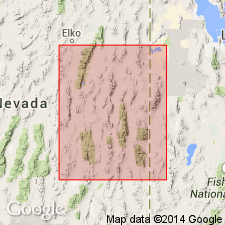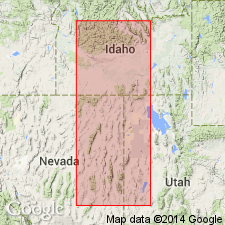
- Usage in publication:
-
- Summit Springs evaporite member
- Modifications:
-
- Named
- Dominant lithology:
-
- Anhydrite
- Gypsum
- AAPG geologic province:
-
- Great Basin province
Summary:
Pg. 102. Summit Springs evaporite member of Pequop formation. Middle Leonardian evaporite sequence drilled at 4,400 to 5,400 feet. Underlies an evaporite dated [early] Guadalupian and assigned on basis of stratigraphic position and faunal control (fusulinids), to [Pequop] formation (new). Overlies Lower Moorman Ranch member [in subsurface only?] and underlies Upper Moorman Ranch member [in subsurface only?]. Little surface expression of this member. [Presence of anhydrite and gypsum implied, but neither lithology nor lithologic sequence described. Upper and lower contacts not described.]
[Type locality not designated.] Recognized in subsurface, depth-interval 4,400 to 5,400 ft, Standard of California-Continental Summit Springs Unit No. 1 well, [NW/4] NW/4 sec. 30, T. 20 N., R. 60 E., White Pine Co., NV. Named from Summit Springs Unit No. 1 well.
[Lower Moorman Ranch member and Upper Moorman Ranch member not adopted by the USGS as formal members; nomenclature guidelines state the use of identical geographic names to several minor units in one vertical sequence is considered informal nomenclature (CSN, 1933; ACSN, 1961, 1970; NACSN, 1983, 2005, 2021).]
[Misprint: US geologic names lexicon (USGS Bull. 1200, p. 3768) states Summit Springs is assigned to Loray formation; should be Pequop formation. And, the Summit Springs well is located in NW/4 sec. 30. GNU records state it is in NW/4 NW/4 sec. 30. Uncertain which of these is correct. --unresolved.]
Source: US geologic names lexicon (USGS Bull. 1200, p. 3768): supplemental information from GNU records (USGS DDS-6; Denver GNULEX).

- Usage in publication:
-
- Summit Springs Member
- Modifications:
-
- Revised
- AAPG geologic province:
-
- Great Basin province
Summary:
Term "Evaporite" not used as part of formal name. Revised in that Pequop assigned to Arcturus Group (rank raised). Overlies Riepetown Formation of Arcturus and underlies Loray Formation, upper formation of Arcturus. In areas where the lower part of the Arcturus cannot be divided, Pequop rests on the Ferguson Mountain Formation of Arcturus. Divisible into 3 [?] members --"Lower Moorman Ranch Member," Summit Springs Member, and "Upper Moorman Ranch Member" [use of lower and upper as applied to the Moorman Ranch was considered informal in the 1961, Code of Stratigraphic Nomenclature, art 10h, the code to be followed in 1964; "Two names should not be derived from the same geographic name" NASC, 1983, art. 7a.] Term Pequop used across the report area from eastern NV into western UT in the Great Basin province. Correlation chart. Cross sections. Of Leonardian, [Early] Permian age. Detailed history of usage of Pequop. Nomenclature chart. Cross sections. Graphic section.
Source: GNU records (USGS DDS-6; Denver GNULEX).
For more information, please contact Nancy Stamm, Geologic Names Committee Secretary.
Asterisk (*) indicates published by U.S. Geological Survey authors.
"No current usage" (†) implies that a name has been abandoned or has fallen into disuse. Former usage and, if known, replacement name given in parentheses ( ).
Slash (/) indicates name conflicts with nomenclatural guidelines (CSN, 1933; ACSN, 1961, 1970; NACSN, 1983, 2005, 2021). May be explained within brackets ([ ]).

